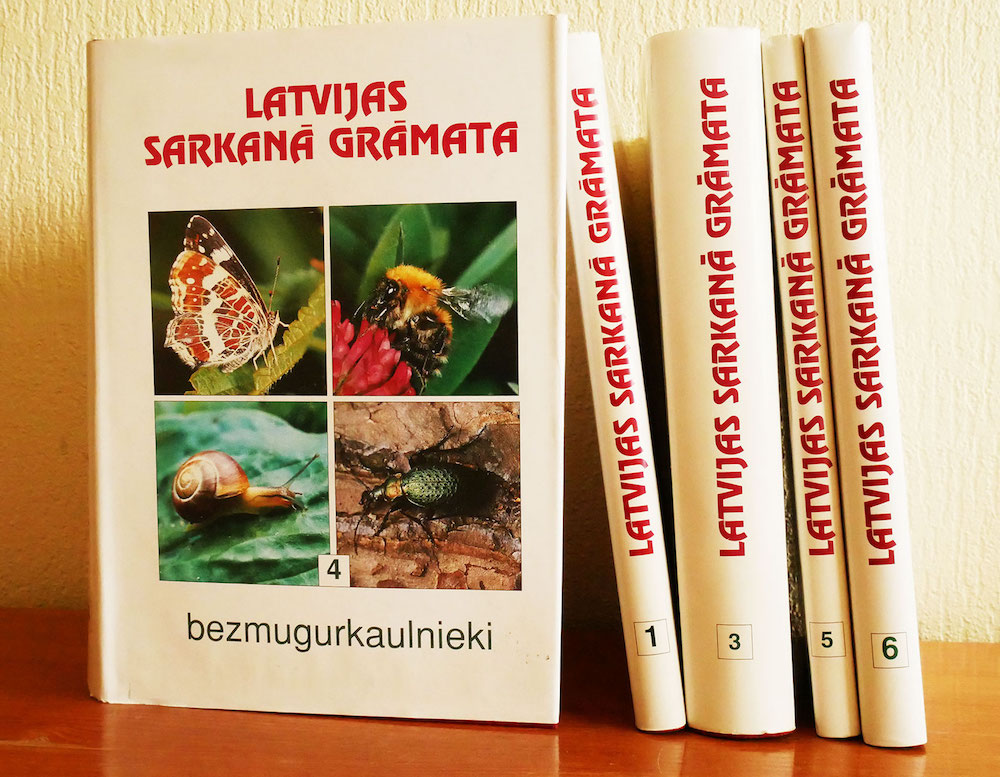In order to protect and preserve the diversity of plant and animal species in the world, Red Books or Red Lists of Endangered Species are created. It was started by the International Union for Conservation of Nature and Natural Resources (IUCN), which published the first list of endangered animals in 1948.
In order to prepare the first Red Data Book or Register on Endangered and Rare Plant and Animal Species in Latvia, in 1977 the Council of Ministers of the Latvian SSR adopted a decision establishing the Red Data Book Council of the Latvian SSR, which operated at the Institute of Biology of the Latvian Academy of Sciences (LAS) - Institute of Biology, University of Latvia. The Council considered and adopted decisions on the inclusion or exclusion of the species in the Red Data Book of the Latvian SSR.
The list of plant and animal species to be included in the Latvian Red Data Book with the descriptions of the respective species was approved in 1980 (the original is kept at the Institute of Biology of the University of Latvia). The Red Data Book was handwritten - the text was typed, pictures of the species were drawn by hand, re-photographed and pasted into the species section. Species distribution maps were drawn by hand on printed forms. All pages of the book were stapled so that the information could be easily updated in the future. This Red Data Book was published in 1985. Its popular scientific version on animals was published in 1990 and on plants in 1992. The species listed in the Red Data Book were specially protected, their extraction and collection was prohibited in accordance with the decision no. 17 of the Council of Ministers of the LSSR of 12 January 1984.

The first Red Book listed 112 species of vascular and ferns and 119 species of animals, including 106 species of vertebrates and 13 species of invertebrates. They were classified into five categories according to the status and distribution of the species in the Latvian SSR, as well as based on certain criteria. The preparation period of the first Latvian Red Data Book was relatively short, so it was not possible to fully assess all species in need of conservation and protection. As a result, several groups of plants and animals were not included in the book.
In the period from 1996 to 2003, the second edition of the Latvian Red Data Book was published, in which a total of 682 species were recorded. In total, this edition covered five of the six volumes originally planned: 1. - fungi and lichens (38 and 34 species respectively); 3. - vascular plants (319 species); 4. - invertebrates (163 species); 5. - fish, amphibians and reptiles (15, 6 and 3 species respectively); 6. - birds and mammals (80 and 24 species respectively). Unfortunately, Volume 2 on Mosses and Algae was not published.

The species included in the Red Data Book are divided into the following five categories:
0. - extinct species (these are species which have not been found in the last 50 years but which may still have survived in certain places in nature, captivity or culture and which require special national protection in the form of legislation);
1. - endangered species (these are endangered species, they are very rare because their number has fallen to a critical level and their continued existence is not possible without special conservation measures);
2. - declining species (these are species whose numbers are declining and their range narrows over the years due to natural causes, human activity or both; they require control of changes in the number of individuals and special national protection in the form of legislation);
3. - rare species (these are species that are not threatened with extinction, but which occur in such small numbers or in places so limited and specific to the area that they can become extinct quickly; they require special national protection in the form of legislation);
4. - species that are little known or under-researched and may be in danger of extinction, but the status of these species cannot yet be accurately assessed due to a lack of data; they need further research.
In the book, each species has its own section, which includes information on the endangerment of the species, the original drawing of a specialist biologist, a map with the distribution of the species in Latvia, morphological description, habitat description, species biology (feeding, reproduction, etc.), distribution and occurrence in Latvia, measures and proposals for the protection of the species, sources of information.
All volumes of the book were prepared and published with the financial support of the European Community's LIFE program and were the first LIFE co-financed project in Latvia.
The Latvian Red Data Book currently has no “rule of law”, as there are other regulations that affect and regulate the protection of species in Latvia.
The long-term director of the LAS Institute of Biology, Dr. biol. Gunārs Andrušaitis, under whose leadership both mentioned editions of the Latvian Red Data Book were developed. The main compilers of the Latvian Red Data Book published in 1985 were Vita Aigare, Juris Lipsbergs, Ilona Lodziņa, Laima Tabaka, Gunārs Andrušaitis and a number of scientists. In turn, more than 50 scientists in the relevant fields have made a significant contribution to the selection and description of species in the latest edition: botanists, mycologists, lihenologists, ornithologists, entomologists, ichthyologists, etc.